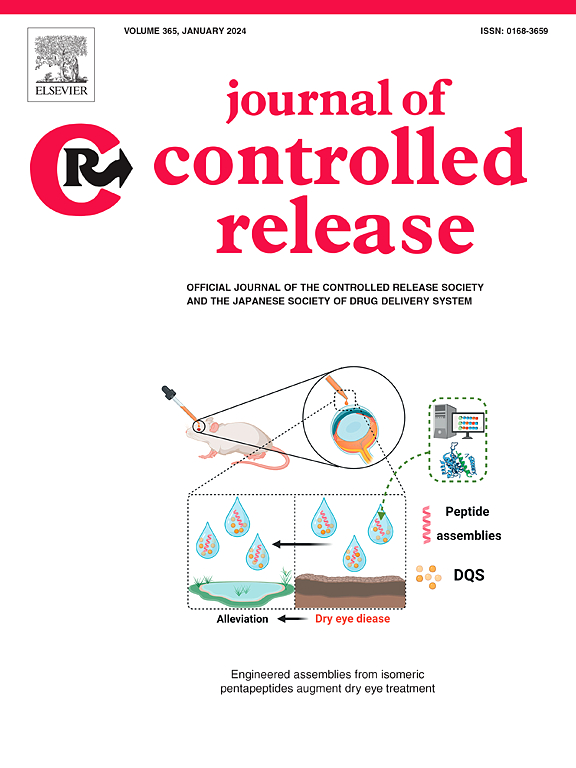Intranasal delivery of extracellular vesicles: A promising new approach for treating neurological and respiratory disorders
IF 10.5
1区 医学
Q1 CHEMISTRY, MULTIDISCIPLINARY
引用次数: 0
Abstract
Background
Extracellular vesicles (EVs) are membrane vesicles secreted by all types of cells, including bacteria, animals, and plants. These vesicles contain proteins, nucleic acids, and lipids from their parent cells and can transfer these components between cells. EVs have attracted attention for their potential use in diagnosis and therapy due to their natural properties, such as low immunogenicity, high biocompatibility, and ability to cross the blood-brain barrier. They can also be engineered to carry therapeutic molecules. EVs can be delivered via various routes. The intranasal route is particularly advantageous for delivering them to the central nervous system, making it a promising approach for treating neurological disorders.
Scope of review
This review delves into the promising potential of intranasally administered EVs-based therapies for various medical conditions, with a particular focus on those affecting the brain and central nervous system. Additionally, the potential use of these therapies for pulmonary conditions, cancer, and allergies is examined, offering a hopeful outlook for the future of medical treatments.
Major conclusions
The intranasal administration of EVs offers significant advantages over other delivery methods. By directly delivering EVs to the brain, specifically targeting areas that have been injured, this administration proves to be highly efficient and effective, providing reassurance about the progress in medical treatments. Intranasal delivery is not limited to brain-related conditions. It can also benefit other organs like the lungs and stimulate a mucosal immune response against various pathogens due to the highly vascularized nature of the nasal cavity and airways. Moreover, it has the added benefit of minimizing toxicity to non-targeted organs and allows the EVs to remain longer in the body. As a result, there is a growing emphasis on conducting clinical trials for intranasal administration of EVs, particularly in treating respiratory tract pathologies such as coronavirus disease.

鼻内输送细胞外囊泡:治疗神经和呼吸系统疾病的一种有前途的新方法。
背景:细胞外囊泡(EVs)是由各种类型的细胞分泌的膜囊泡,包括细菌、动物和植物。这些囊泡含有来自母细胞的蛋白质、核酸和脂质,并能在细胞间转移这些成分。由于其低免疫原性、高生物相容性和穿越血脑屏障的能力等天然特性,电动汽车在诊断和治疗方面的潜在应用受到了人们的关注。它们也可以被改造成携带治疗分子。电动汽车可以通过各种路线交付。鼻内途径特别有利于将它们输送到中枢神经系统,使其成为治疗神经系统疾病的有希望的方法。综述范围:本综述深入探讨了鼻内给药ev为基础的治疗各种疾病的前景潜力,特别关注那些影响大脑和中枢神经系统的疾病。此外,这些疗法对肺部疾病、癌症和过敏的潜在用途也进行了研究,为未来的医学治疗提供了一个充满希望的前景。主要结论:鼻内给药ev比其他给药方式具有显著优势。通过直接将电动汽车输送到大脑中,专门针对受伤区域,这种管理被证明是高效和有效的,为医学治疗的进展提供了保证。鼻内给药并不局限于与大脑有关的疾病。由于鼻腔和气道的高度血管化,它还可以对肺部等其他器官有益,并刺激粘膜免疫反应,对抗各种病原体。此外,它还有一个额外的好处,即最大限度地减少对非目标器官的毒性,并允许电动汽车在体内停留更长时间。因此,人们越来越重视进行鼻内给药ev的临床试验,特别是在治疗冠状病毒病等呼吸道疾病方面。
本文章由计算机程序翻译,如有差异,请以英文原文为准。
求助全文
约1分钟内获得全文
求助全文
来源期刊

Journal of Controlled Release
医学-化学综合
CiteScore
18.50
自引率
5.60%
发文量
700
审稿时长
39 days
期刊介绍:
The Journal of Controlled Release (JCR) proudly serves as the Official Journal of the Controlled Release Society and the Japan Society of Drug Delivery System.
Dedicated to the broad field of delivery science and technology, JCR publishes high-quality research articles covering drug delivery systems and all facets of formulations. This includes the physicochemical and biological properties of drugs, design and characterization of dosage forms, release mechanisms, in vivo testing, and formulation research and development across pharmaceutical, diagnostic, agricultural, environmental, cosmetic, and food industries.
Priority is given to manuscripts that contribute to the fundamental understanding of principles or demonstrate the advantages of novel technologies in terms of safety and efficacy over current clinical standards. JCR strives to be a leading platform for advancements in delivery science and technology.
 求助内容:
求助内容: 应助结果提醒方式:
应助结果提醒方式:


